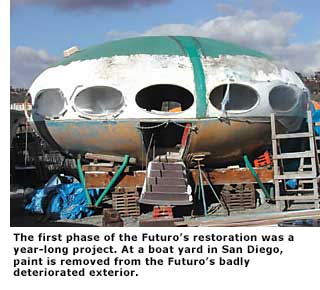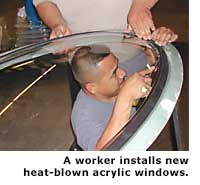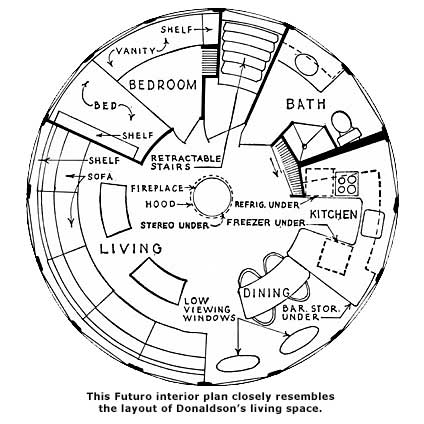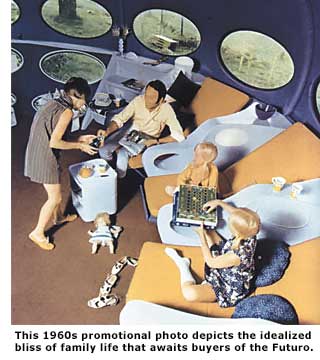Falling for a Futuro - Page 2
Soon there were Futuro ski cabins in Russia and a diner in Finland, a Futuro café in the Crimea, and Futuros atop Swedish Army lookout towers. 'Futuro: Tomorrow's House from Yesterday,' by Marko Home and Mika Taanila, the 2002 book that has helped rejuvenate the Futuro's reputation, estimated that about 60 Futuros were produced worldwide, 20 of them in Finland. 'Playboy' gave the Futuro a boost in 1970 with a spread (no nudes, alas) that made the Futuro's interior appear large enough to be a discotheque. "The ultimate 'Playboy' pad," the magazine called it.
The Futuro literature is littered with glittering projects that never came to be. A hotel in Kansas City planned to use Futuros as a 'VIP Outer Orbit Suite.' Skyscrapers were planned with slots for individual Futuros. "Since people are moving every five years," Donaldson says, "why not have a house that you can pick up, go to a tower, plug it in, and you're in the city of your choice?"
Suuronen and Polykem also produced a slightly more commercially successful sister house, the Venturo. A lozenge-shaped box with squared sides, it wasn't as flying saucer-like as the ellipsoid Futuro.

None of this, however, had much impact on the overall housing market—though steel, plastics, and other industrial materials got a lot of ballyhoo. Joe Eichler never bought the idea, however, his son Ned Eichler wrote in his book, 'The Merchant Builders.'
"Most merchant builders had their doubts," Ned admitted, about what the magazine 'House and Home' was promoting as a 'truly industrialized house.' "At Eichler Homes we were especially skeptical," because of the company's experience building two steel-frame houses, including one, the X-100, which used plastic-coated exterior panels.
Donaldson himself was deeply involved with prefabricated plastic buildings at the time. A military kid who grew up around San Diego, Donaldson was always fascinated with technology. His favorite superhero was Plastic Man. From model airplanes he got into the hang gliding movement early, when it was build-your-own. Soon he was flying his own rigid-wing biplane hang glider. He also fell in love with inflatable plastic and worked on "inflatable designs that people could live in."
With a colleague, Donaldson worked on a prefabricated fiberglass-and-urethane-foam house, called a Poly-Pod, that was much like the Futuro. It went into limited production but didn't last.

The Futuro and its plastic brethren were done in by 1973. During that era's Arab oil embargo, when motorists lined up for gas, petroleum prices rocketed, Donaldson says. Plastic was no longer cheap, nor competitive with wood or metal as an architectural material. Embargo or no, the Futuro came with some built-in problems. It was small, oddly shaped, and expensive. Critics called it 'the Mercedes-Benz' of prefabricated houses.
Inside Donaldson's Futuro, the walls are curved, there's a built-in bench with under-seat storage, the 'kitchen' barely deserves the name, and the bedroom is only slightly larger than its built-in queen bed. The centerpiece of the living area is a fire pit and metal flue.
The elliptical acrylic windows are shaped like the house itself, as are the door handles. The two rows of windows originally didn't open. Building codes forced Donaldson to provide ones that do. The door is a ramp. Unlike the average mountain cabin, there's no outside deck.

The American version was altered to appeal to the American market, Donaldson says. But it didn't work. "I don't think a round house with non-operable oval windows was particularly attractive to a 1960s American housewife," he says.

The interior provides 500 feet of living space, not 300 as in Suuronen's original—and without altering the exterior dimensions, Donaldson says. The American design accomplished this by raising the floor a few feet. Because of the revised plan, the kitchen sink backsplash cuts clumsily into the view from one of the windows.
The arrangement of windows also differs from the Finnish version, which had three rows. And the Finnish Futuro sat, like an egg in an eggcup, in a metal ring that attached to the spider legs. Here, the legs emerge from the Futuro itself.




